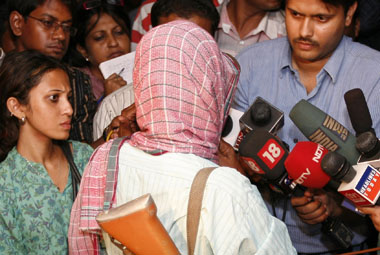Kolkata: A shrewd fighter and a marksman, top Maoist leader Kishenji spent three decades of his life in hiding, waging a relentless, bloody war against the state to emerge as the biggest security headache for the West Bengal Government and the Centre. Born Mallojula Koteswara Rao in an Andhra village, the media-friendly 58-year-old cotton-clad commander was the face of the Maoist movement in India. Kishenji’s image in public is that of a man with his face covered with a striped scarf around his head and an AK-47 assault rifle slung across his shoulder. He has been under immense pressure since the start of ‘Operation Greenhunt’ in 2009 and other counterinsurgency operations throughout the Maoist stronghold in the ‘Red Corridor’. Active in the Lalgarh area of West Bengal, he has regularly vacillated on peace talks with the Centre, often saying that he refuses to lay down arms as a pre-condition. [caption id=“attachment_139742” align=“alignleft” width=“380” caption=“Kishenji’s image in public is that of a man with his face covered with a striped scarf and an AK-47 assault rifle slung across his shoulder. Reuters”]  [/caption] A Politburo member of the banned Communist Party of India (Maoist) and the group’s military leader, he had claimed responsibility for the Silda camp attack in West Bengal in 2010 — 24 paramilitary personnel of Eastern Frontier Rifles (EFR) were killed in the massacre “This is our ‘Operation Peace Hunt’. It is our retaliation against ‘Operation Green Hunt’ of the government,” an unrepentant Kishenji told local television stations in Kolkata after the attack. Union Home Minister P Chidambaram and Chief Minister Mamata Banerjee have dubbed Maoists as deadlier than terrorists. The second in-command of the outfit and in-charge of military operations in junglemahal since 2009, Kishenji has given regular interviews to the media from an unknown location. He has previously used Prahlad, Murali, Ramji, Jayant and Sridhar as aliases. In one of the media interviews, Kishneji claimed he does not “kill easily” but the violence he has unleashed betrays his claim. He once even described himself as a “soft-hearted person, willing to forgive”. The rebel went underground a year after the Emergency in 1975 and came in contact with CPIM(L) leaders. In 1980, he co-founded People’s War Group in Andhra Pradesh, rose to being politburo member and was put in charge of organising movements in the Telangana region and Dandakaranya in AP. In the early 1990s, he moved to Bihar, then a Maoist Communist Centre of India (MCCI) stronghold. Kishenji set about orchestrating a merger of the two radical forces. Inspite of strong differences, he succeeded in unifying PW and MCC in 2004. This brought him to the tribal belt of West Bengal, where he soon showed his aggressiveness and hunger for power. He has been accused of sidelining Maoist leaders in West Bengal and expelled several senior leaders who fell out with him. Now, he is the undisputed Number 2 in the eastern region behind Ganpati. Reports of Kishenji missing from the front after a recent injury had led to speculation about his future in the Maoist movement but judging by his audacious, repeated public statements he displayed no intention of giving up the armed struggle. The estimated 22,000 insurgents believed to be under Kishenji’s command have traditionally used hit-and run attacks and ambushes on security forces comprised of small arms fire, laying anti-personnel and anti-vehicular mines. In the past few years, they have become quite adept at using Improvised Explosive Devices(IED) to inflict mass casualties on their opponents who often travel and congregate in large groups. PTI
Union Home Minister P Chidambaram and Chief Minister Mamata Banerjee have dubbed Maoists as deadlier than terrorists.
Advertisement
End of Article
Written by FP Archives
see more


)
)
)
)
)
)
)
)
)



